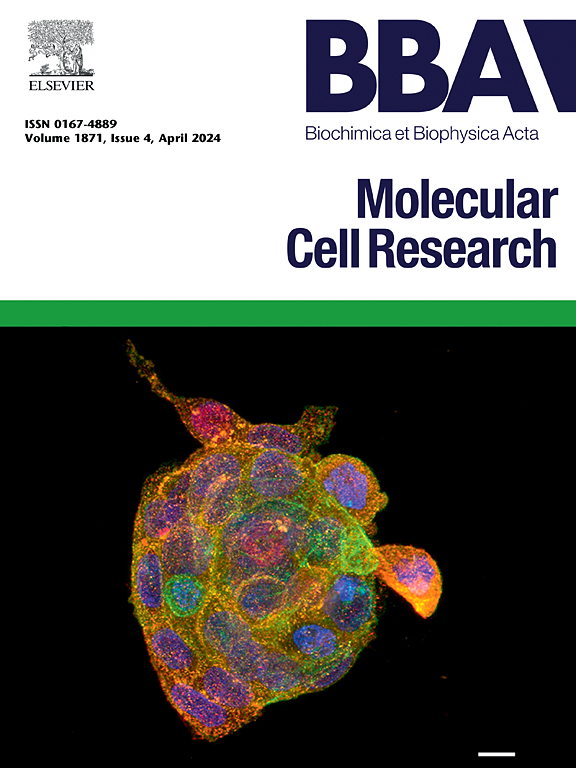表观遗传靶向DNA损伤反应(DDR)相关机制克服肿瘤细胞获得性顺铂耐药。
IF 4.6
2区 生物学
Q1 BIOCHEMISTRY & MOLECULAR BIOLOGY
Biochimica et biophysica acta. Molecular cell research
Pub Date : 2025-07-02
DOI:10.1016/j.bbamcr.2025.120018
引用次数: 0
摘要
DNA损伤反应(DDR)的机制被认为是克服肿瘤细胞耐药的有效靶点。我们研究了不同类别的组蛋白去乙酰化酶抑制剂(HDACi)(即广谱HDACi(伏立诺他),I类HDACi(恩替诺他),优先IIb类HDAC6i(立可立他)和双重HDAC类I/IIb抑制剂(HDAC1/6i))对亲代(J82WT)和顺铂(CisPt)耐药膀胱癌细胞(J82CisR)的DDR机制的影响。恩替诺他单药治疗显示出相对较低的基因毒性和ddr激活效力,同时显示出与其他HDACi相似的抗增殖、细胞毒性和促凋亡活性。尽管单独治疗时,恩替司他的DNA双链断裂(DSB)形成能力较低,但与顺铂联合治疗后,在J82CisR中,恩替司他具有最高的协同细胞毒性(CI ≤ 0.8)。值得注意的是,这种效应与Pt-(GpG)- dna -链内交联的形成无关。Entinostat增加cispt诱导的DNA链断裂水平,促进复制和转录阻断,pRPA32灶形成,PARP-和caspase-7切割,影响ddr相关因子(如γH2AX, pp53, pRPA32, pKap1)的激活,逆转cispt诱导的p53乙酰化,阻断药物刺激的多种DSB (HR, NHEJ)-和BER修复相关因子的mRNA表达。综上所述,i类选择性HDACi entinostat单用时ddr激活效力最低,与CisPt合用时抗癌效果最高,可能与抑制HDAC3有关。这是由于CisPt治疗引起的复制和转录应激扩增,以及对DDR机制和DNA修复的干扰,最终促进细胞凋亡。因此,通过I类HDACi的表观遗传靶向ddr相关的死亡途径有助于克服肿瘤细胞获得性CisPt耐药。本文章由计算机程序翻译,如有差异,请以英文原文为准。

Epigenetic targeting of DNA damage response (DDR)-related mechanisms to overcome acquired cisplatin resistance of tumor cells
Mechanisms of the DNA damage response (DDR) are considered as useful targets to overcome tumor cell resistance. We investigated the impact of various classes of histone deacetylase inhibitors (HDACi) (i.e. broad-spectrum HDACi (vorinostat), class I HDACi (entinostat), preferential class IIb HDAC6i (ricolinostat) and dual HDAC class I/IIb inhibitors (HDAC1/6i)) on mechanisms of the DDR using parental (J82WT) and cisplatin (CisPt)-resistant bladder carcinoma cells (J82CisR). Mono-treatment with entinostat revealed relatively low genotoxic and DDR-activating potency, while showing similar antiproliferative, cytotoxic and pro-apoptotic activities as the other HDACi. Despite its low DNA double-strand break (DSB) forming potency with mono-treatment, entinostat conferred the highest synergistic cytotoxicity (CI ≤ 0.8) in J82CisR following co-treatment with cisplatin. Notably, this effect is independent of Pt-(GpG)-DNA-intrastrand-crosslink formation. Entinostat increased the level of CisPt-induced DNA strand-breaks, promotes replication and transcription blockage, pRPA32 foci formation, PARP- and caspase-7 cleavage, influenced the activation of DDR-related factors (e.g. γH2AX, pp53, pRPA32, pKap1), reverted CisPt-induced p53 acetylation and blocked drug-stimulated mRNA expression of multiple DSB (HR, NHEJ)- and BER repair-related factors. Summarizing, the class I-selective HDACi entinostat reveals the lowest DDR-activating potency in mono-treatment and the highest anticancer efficacy in combination with CisPt, likely involving inhibition of HDAC3. This is due to amplification of replicative and transcriptional stress caused by CisPt treatment as well as interference with mechanisms of DDR and DNA repair, eventually promoting apoptosis. Thus, epigenetic targeting of DDR-related death pathways by class I HDACi is useful to overcome acquired CisPt resistance of tumor cells.
求助全文
通过发布文献求助,成功后即可免费获取论文全文。
去求助
来源期刊
CiteScore
10.00
自引率
2.00%
发文量
151
审稿时长
44 days
期刊介绍:
BBA Molecular Cell Research focuses on understanding the mechanisms of cellular processes at the molecular level. These include aspects of cellular signaling, signal transduction, cell cycle, apoptosis, intracellular trafficking, secretory and endocytic pathways, biogenesis of cell organelles, cytoskeletal structures, cellular interactions, cell/tissue differentiation and cellular enzymology. Also included are studies at the interface between Cell Biology and Biophysics which apply for example novel imaging methods for characterizing cellular processes.

 求助内容:
求助内容: 应助结果提醒方式:
应助结果提醒方式:


